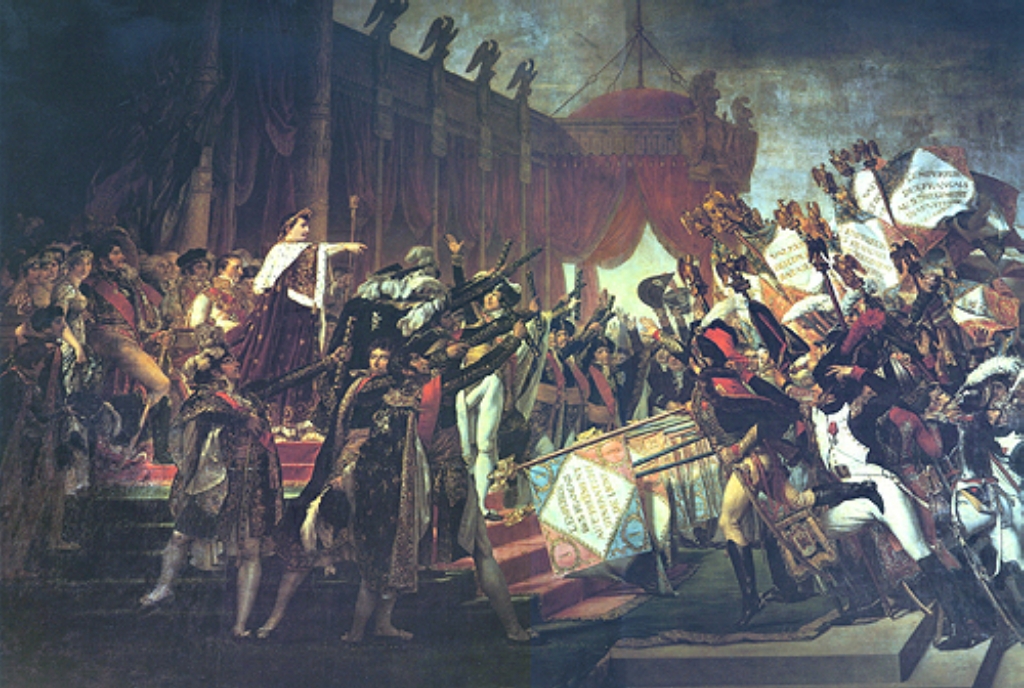
For fascinating information about symbolism see http://rexcurry.net/book1a1contents-swastika.html
Hear audio on worldwide radio at http://rexcurry.net/audio-rex-curry-podcast-radio.html
 DISTRIBUTION OF THE EAGLE STANDARDS
by JACQUES LOUIS DAVID
DISTRIBUTION OF THE EAGLE STANDARDS
by JACQUES LOUIS DAVID
|
Pledge of Allegiance
in
images & articles at http://rexcurry.net/book1a1contents-pledge.html
For fascinating information about symbolism see http://rexcurry.net/book1a1contents-swastika.html Hear audio on worldwide radio at http://rexcurry.net/audio-rex-curry-podcast-radio.html |



Also see The Note-Books of Captain Coignet: Soldier of the Empire, 1799-1816
By Captain Jean-Roch Coignet. Greenhill Books have begun reprinting
these and have recently published one of the most famous memoirs of the
period: The Note-Books of Captain Coignet! As a member of the 1st
Battalion of the 1st Grenadiers of the Old Guard, he witnessed many of the
great events of the era. Whether it was the meeting of the two Emperors
on the raft at Tilsit or the wedding of Napoleon to Marie Louise or the
distribution of the Eagles in 1815, Coignet saw it all and recorded it with
great detail.
one of the most spectacular ceremonies of the french 1st Empire - the eagles
distribution that took place in Paris on the 5th december 1804 (14 frimaire
an XIII), three days after Napoleon's Sacre.
Jacques-Louis David
Study for "The Distribution of the Eagles": Dragoon Raising an Eagle
c. 1808–10
Black crayon on paper
9 x 6 7/8 in.
Musée national du Château de Versailles
Study for "The Distribution of the Eagles": Napoleon in Imperial Robes
c. 1808–10
Black crayon on paper
9 7/8 x 7 3/4 in.
Musée national du Château de Versailles
Study for "The Distribution of the Eagles": Sapper-Granadier of the Guard
c. 1808–10
Black crayon on paper
9 7/8 x 7 3/4 in.
Musée national du Château de Versailles
Study for "The Distribution of the Eagles": The Empress Josephine
c. 1809
Black crayon on paper
9 5/8 x 7 3/4 in.
The Art Institute of Chicago. The Helen Regenstein Collection
A painting entitled Première distribution de la Légion
d'honneur au camp de Boulogne, le 16 août 1804,
Charles Etienne Pierre Motte (1785-1836), d'après Victor-Jean Adam
(1801-1866)
Lithographie en couleur, France, vers 1830, H. 31 x l.44 cm
Inventaire Armée 07840 / N° de cote Fd 550
Below is from http://www.napoleonicsociety.com/english/Life_Nap_Chap22.htm
Bernard-Germain-Étienne de la Ville, Count Lacépède (1756-1825) was designated Grand Chancellor. It was to emphasize the civilian aspect of the new entity that Bonaparte chose this esteemed and celebrated naturalist. Lacépède henceforth devoted his whole life to the Legion of Honour, whose immediate and prodigious progress was in large measure due to him. The distinction had three grades, Knight, Officer and Commandant (today Commander) and two orders, Grand Officer and Grand Eagle (today Grand Cross). The form of the decoration was determined by the decree of July 1, 1804: a star, enamelled in white, with five radiating arms each ending in twin points, suspended from a red moiré ribbon. An honorarium was attached to each grade. The annual stipend was 500 francs for a Knight, 1000 francs for an Officer, 2000 francs for a Commandant and 5000 francs for Grand Officer; Grand Eagles most often received donations in the form of châteaux. Special Legion of Honour schools were also opened for the instruction of the daughters of legionnaires.
The first ceremony at which the decoration was awarded took place in the great parade ground of les Invalides of July 15, 1804. Each recipient had the medal bestowed on him by Napoleon himself. One after another, marshals and generals presented themselves before the Emperor: Oudinot, Macdonald and Marmont, Cardinal Fesch, Cambacérès, Talleyrand, the mathematicians Monge and Laplace, Prony, Cuvier, Montgolfier, Fontanes, Denon, David, Méhul, Bernardin de Saint Pierre, veterans wounded in the wars of the Republic, officers and grenadier Jean-Roch Coignet
Yet the splendour of the ceremony at les Invalides was surpassed by the one that was held on August 16 at the camp at Boulogne in the presence of two hundred thousand officers, non-commissioned officers, and soldiers. It was on that day that the Legion of Honour truly entered the soul of the nation. Its impact was universal. The day was commemorated by the erection of a column topped by the statue of the Emperor. This column was to suffer very serious damage in 1944, and was restored in 1962 with a new statue by sculptor P. Stenne.
The Legion of Honour was very soon intimately woven into the very fabric of French life. It also fulfilled the mission bestowed on it by its founder: by promoting a mixture of French people of all origins and social classes, it strengthened the foundations of the nation. A decree was issued in June 1804 authorizing the admission of foreigners; thus it was that the great German writer Johann Wolfgang von Goethe received the decoration from the hands of the Emperor, of whom he remained a fervent admirer until the end of his days: “Napoleon always sought virtue, but since it did not exist in politics, he turned to power.”
The Legion of Honour has survived all the convulsions of history. Even Charles X (the Comte d’Artois), who had Napoleon assassinated on St. Helena after several unsuccessful attempts (including the bomb attack of 1800 and sending Cadoudal and Pichegru to France in 1803) dared not suppress it for fear that such a decision would spark a new revolution.
Faced with the extraordinary success of the Legion of Honour, it might be thought that all the intellectuals and political figures who participated in its creation enthusiastically supported the project. Leadership requires foresight, and a prime quality of every decision-maker is the ability to anticipate. Napoleon did not foresee any serious opposition to his plan and encountered the same difficulties as with the Concordat, the Civil Code and public education.
Thibaudeau, who was personally against the plan, has more to say on this: "On May 4, 1802, Roederer, at the request of the First Consul, read the proposal for the creation of the Legion of Honour before the Council of State. Mathieu Dumas supported the project, on condition that the decoration be reserved exclusively for military personnel.”
Bonaparte: That would have been a good idea in the Middle Ages or in the days when the Franks were conquering Gaul, when an individual's rank was decided by his physical strength and bravery. Today we have a nation of 30 million citizens, united for good or ill, of which the Army represents only a small fraction. It is the civilians who are the primary strength of the nation and the best among them should receive a national award that is the same as that given to soldiers. It will be a means of consolidating the links between us all and forging an indissoluble union.
This argument, delivered with such a rare mixture of eloquence and common sense, had a profound effect on the Council. The force of the words was backed up by the fact that they were spoken by the head of the government who was also the most famous of French generals.
The debate continued on May 8, 1802: several opponents rejected the very principle of a system of reward by decoration. The major objection was that this would create an order that would put an end to equality. In a republic, they asserted, the only way to reward a deserving citizen was to give him a job commensurate with his abilities; crosses and ribbons were baubles fit only for monarchies. Berlier and others quoted examples borrowed from the Greeks and Romans.
Bonaparte: You speak of the Romans. It is curious that you should cite them as an example, since it was among them that the system of rank and caste was pushed to its limit. The Romans had their patricians, their knights, their citizens and their slaves. When the patricians disappeared, Rome fell into decadence. The deepest sentiment among our compatriots is Honour. We must keep this feeling alive and we cannot do so without creating distinctions.
On May 19, 1802, the plan for the creation of the Legion of Honour was submitted to a vote in the assemblies. These are the results:
In the State Council 14 for, 10 against.
In the Tribunat 56 for, 38 against
in the Legislative Corps 166 for, 110 against
The total was 236 votes for and 158 against, a margin of only 78 votes. None of Napoleon's other projects had met with such strong opposition.
On January 28, 2002, Jacques Chirac, the President of the French Republic, opened the celebrations in honour of the 200th anniversary of the creation of the Legion of Honour at the Élysée Palace. This is an excerpt from his speech:
"Why then has this small white star suspended from a red ribbon been so sought after and respected for the last 200 years? Why is the Legion of Honour one of the most famous, if not the most famous, decoration, in the world? Why after 200 years has it served as a model for so many national orders in Europe and throughout the world?
It is not the oldest order. Some orders go back to the time of the Crusades. Yet the Legion of Honour remains France’s highest distinction. It is the one that has survived all the changes of regime and all the numerous crises and difficult times that have marked our history. Its original statutes have been amended many times, but its basic principles remain unchanged.”
In 1802 France was at peace: a treaty had just been signed at Lunéville with Austria, another at Amiens with England and a third, the Concordat, with the Vatican. Consequently, the First Consul was able to devote himself to internal affairs such as the creation of administrative, legal and financial institutions, several which still govern the everyday affairs of our country. The Order of the Legion of Honour is one of these.
The revolution of 1789 had abolished all orders and decorations. The Directory decided to reintroduce the ancient tradition of rewarding soldiers for acts of bravery by bestowing arms of Honour. Bonaparte applied this measure as early as the first Italian campaign of 1796. Thus it was that a young drummer from Arcole received two silver drumsticks, which are today on display in the national Museum of the Legion of Honour.